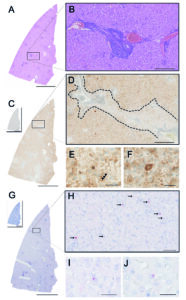The ferret is commonly used as an animal model for studying viral diseases, including the flu and SARS-CoV-2. However, compared to other animals used in experimental studies, we don’t know as much about the ferret’s underlying infections. Thus it is even more important to properly assess the ferret in order to ensure consistency and accuracy in disease characterization prior to further applications such as therapeutic assessment.
When SARS-CoV-2 first emerged, experts at the Animal and Plant Health Agency in the UK studied the virus in ferrets. During this study, Dr. Fabian Lean and colleagues noticed changes in the liver tissue that appeared as multifocal infiltration with lymphocytes and plasma cells. They initially wondered if this was caused by the SARS-CoV-2 challenge. However, after ruling out SARS-CoV-2 infection (viral RNA and antigens; molecular and microscopy techniques), they found that the changes reflected a chronic inflammatory process.
Then advanced molecular techniques were used to analyze the ferrets’ genetic material and identified genetic reads compatible with ferret hepatitis E virus (FRHEV) across the cohort of ferrets. The team confirmed this using RT-PCR specific to FRHEV. Although uninfected ferrets were not included in the animal trial, they analyzed archive ferret livers from a previous respiratory viral study to enable comparative analysis. These ferrets showed no histological changes and were negative for FRHEV on RT-PCR. Working with colleagues from the University of Zurich and University Hospital Zurich, the team used virus immunolabelling and in situ hybridization and revealed that FRHEV infection was found within the hepatocytes.
This incidental finding underscores the importance of rigorous assessment of animal models and the need to recognize FRHEV as a background infection in ferrets used as laboratory models. The authors still don’t fully understand the mechanism and implications of FRHEV in the ferret, and more studies using a natural host-virus system such as FRHEV in the ferret may help us better understand the pathogenesis of HEV. Additionally, since ferrets are often kept as pets, it would be important to investigate whether FRHEV could infect humans.
This study was published in Journal of General Virology. 2022 Nov;103(11).


